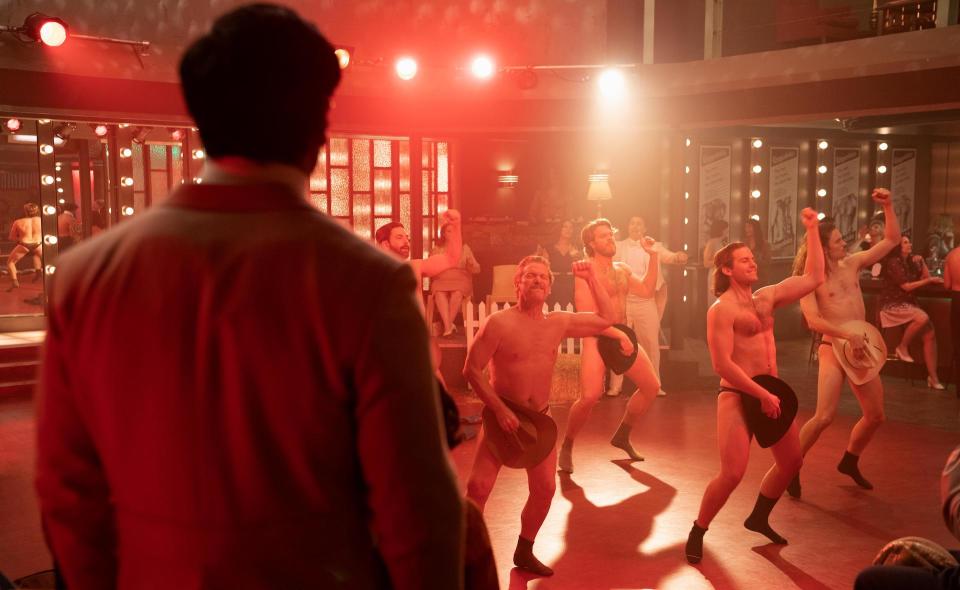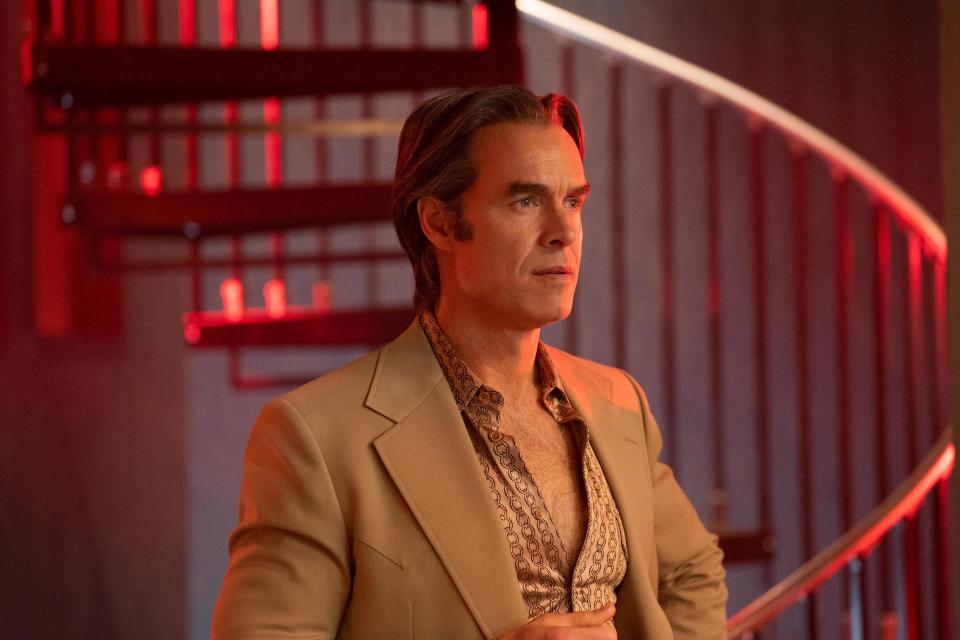Kumail Nanjiani Can Justify Anything

- Oops!Something went wrong.Please try again later.
- Oops!Something went wrong.Please try again later.
- Oops!Something went wrong.Please try again later.
Technically, Kumail Nanjiani turned down the leading role in “Welcome to Chippendales.”
Known for his standup and comedic roles like 2017’s “The Big Sick,” Nanjiani wasn’t ready to take on the dramatic leading role of Chippendales founder Somen “Steve” Banerjee when creator Rob Siegel first approached him. But Nanjiani’s comedy career prepared him perfectly for the savvy megalomaniac behind this storied club.
More from IndieWire
“I used to do a lot of sketches on a show called ‘Portlandia,’ and I always played a guy who was like king of a very small kingdom — he really loved power over it,” Nanjiani told IndieWire via Zoom. “That’s a big aspect of Steve; he’s the king of a very small kingdom, Chippendales, and it’s very important to him that everybody know he is the king, he’s the boss.”
Then there was the “Twilight Zone” episode for Jordan Peele’s 2019 reboot, where Nanjiani played a standup comedian who develops potent superpowers. “It was the first time I played someone who had that kind of power and was using it for evil, so the feeling of playing that was something that really stuck with me,” he recalled. “When ‘Chippendales’ came along, I was like, okay, it’s basically about tapping into that kind of dark inner feeling again, even though the characters on paper are very different.”
The roles prepped Nanjiani almost uncannily; Banerjee’s obsession with power grows throughout the series and his years running Chippendales, and the darkness buried inside him creeps slowly toward the surface until it finally breaks through. And at the end of the day, the Chippendales founder is just…kind of awkward, which Nanjiani played in his recurring role on “Franklin & Bash.”
“I played a very nerdy, nervous, agoraphobic lawyer,” Nanjiani said. “So a little bit of his awkwardness, a little bit of the small tyrant from ‘Portlandia’ and a little bit of the darkness from ‘The Twilight Zone.’ I didn’t know where this character was going to end up, but I knew that those three pieces could somehow be a part of this.”
“Welcome to Chippendales” tells the incredible true story of how the eponymous male strip club started, and how Banerjee teamed up with choreographer Nick De Noia (Murray Bartlett) and they spent close to a decade butting heads and dodging scandal. Ahead of the series premiere on Hulu, Nanjiani talked about getting involved with the project, moving from comedy to drama, and his not-so-conflicted feelings about Banerjee now that the series is wrapped.
This interview has been edited for length and clarity.
IndieWire: How familiar were you with the story before you joined the project?
Kumail Nanjiani: I didn’t know anything about it. I only heard of it through the project. I knew what Chippendales was, but I had no idea all the sordid stuff behind it.
And then how did you get involved initially?
Right after “The Big Sick” came out in 2017, Rob Siegel had written a movie script of this. He contacted me like, “I have the story of the guy who created Chippendales, and I want you to star in it.” I loved the script, but I didn’t feel ready to do it. [Last year, it became a miniseries instead.] I had a bunch more conversations with him, and then one day he was like, “I’m just going to tell you what the whole show is.” He talked me through episode-by-episode, all the stuff that happened; my jaw was on the floor. I couldn’t believe that all this really happened, and by the end of his pitch, I was like, I have no choice but to do this.

Erin Simkin/HULU
You mentioned not being ready a few years ago — this as your first major dramatic leading role, right?
First purely dramatic role, for sure. “The Big Sick” was the first time I’d done anything that wasn’t just purely comedic because it obviously had dramatic elements to it, but I’ve never played a part where I couldn’t be funny.
I’d argue that you still get to be funny sometimes.
Yeah, but in a way where he doesn’t understand, you know? The version of me that I played “The Big Sick” knows he’s funny and he’s being funny, but this guy is funny in ways that I don’t think he understands.
So what was unexpectedly challenging or even easy about making that transition?
As a stand up you get very used to feedback. With dramatic stuff, there is no external feedback. The director will tell you if you’re doing a good job or not, but really the only gauge is yourself. Going into something purely dramatic like this, I knew that that was going to be the challenging thing: How do I trust myself to know when I’ve nailed a scene and when I haven’t when there isn’t any external feedback? I think developing that internal gauge was a challenging thing for me.
Did you watch any of the previous adaptations of Steve Banerjee’s story? There have been a couple of movies in the past.
No, I never do that. I can only do my version of it. I learned that because I was doing this live table read of “Terms of Endearment” — which I love, one of my favorite movies… I was playing the John Lithgow part. I was getting to play this amazing character, so I was like, “I should rewatch ‘Terms of Endearment’ before.”I started watching it and as soon as John Lithgow showed up I freaked out. I was like, “Oh, I can’t do that. That’s John Lithgow, that’s his version of it.” I turned it off and [thought,] “I have to start from scratch.”
What did your role as executive producer look like on this project, since you were also leading the cast?
Really fun! I was a part of things from the beginning: Interviewing the writers, the other producers — Jenni Konner came on, very excited to have her — picking the directors. I was really involved in the edit too, which was really, really fun. That’s my favorite part of the process — just taking a scene and making it the best version of that scene that it can be.
On set, I told all the actors: “If there’s ever any problem come to me.” I’ve been on great sets and I’ve been on sets when people have been unhappy, and the thing that the unhappy sets have in common is a lack of communication. [I told everyone:] “I just want everyone to feel absolutely safe, absolutely comfortable, I want to set you up for the best possible work that you can do.” I actually really loved doing that. I’d never done that before. The only other time I starred in something that I was a producer on was “The Big Sick,” and that was my first thing and I was in a low-level crisis the entire time.
I was gonna say — most people who end up doing two, three, and four hats on a production, it can be very gratifying, but also very overwhelming. Do you feel that way this time? Or do you feel like this was easier after “The Big Sick?”
It’s very, very hard, but it actually helps me get a bigger picture of the show and doesn’t get me so obsessed with the acting of it. Sometimes in between takes you’re sitting and just thinking about the scene, and you can really choke the life out of it by overthinking it. Doing all this other stuff helped keep me loose and gave me a bigger view of the entire thing. It was exhausting, I’ve never been that tired in my life. [But] it was gratifying and I would love to have that role again. It’s not like, “Okay, next thing I just want to act in.” No.
What was the most fun to film?
This [is] gonna be weird to say that it’s fun, but the most exciting and thrilling and satisfying scene to film was me and Robin de Jesus, who plays Ray, are basically in a hotel room for most of the final episode. It’s one 20-page scene and we shot it over three days. You’re kind of living in it, it feels like you’re in the soup the entire time and finding all the little movements in it. Working with a director like Richard Shepard very closely and with Robin, it felt like it was the three of us just putting on this play together. I’ve never done anything like that.

Erin Simkin/HULU
Are you upset that you weren’t asked to be a dancer? You now have dance experience from “The Eternals” and your workout regimen.
Oh, thrilled that I was not asked to dance. These dancers are Broadway dancers, they’re professionals, they’re amazing, and I got to not dance and eat ice cream the entire shoot. It was great. More like this!
I love your relationship with Murray on screen, that Nick and Steve dynamic. It goes through such a range of emotions over the course of the show. What was it like working with him, finding that balance, going from friends to enemies and all over the place?
The thing with Murray is that he is probably the most good person I’ve ever met in my life. He’s just such a genuinely kind, wonderful human being. Actors have different processes and I don’t want to judge anyone’s process, but for me, it’s really important that I feel that I love all the people I work with. It was really easy to be shitty in scenes with him, because off-camera we were so close and love each other so much that when it was action you could really go for the jugular.
I used to be intimidated to work with truly great actors, but now I’m excited because they can carry you through a scene. All you have to do is see them, respond to them, listen to them, and that’s the scene. Every single scene I had with Murray was a thrill and joy.
Steve is such a complex person — not just character. How do you feel about him now looking back at the series and having played him?
As I was shooting it, I never judged him and I never felt like he did anything wrong, because I justified everything I was doing — everything he was doing — so even the bad decisions made sense to me. They felt inevitable to me. It wasn’t until I watched the first rough cuts of Episodes 7 and 8 that I was like, “Oh, he’s a really bad guy!” I got infuriated, it was almost hard for me to watch this guy doing the wrong thing over and over and over and over when he’s been given every chance in the world to do the right thing. [While] I was doing it I was like, “Yeah, he’s right, everybody else is wrong.” And now I’m like, “Oh, no, he’s wrong. Everybody else was right.”
The first two episodes of “Welcome to Chippendales” are now streaming on Hulu, with new episodes every Tuesday.
Best of IndieWire
The Best True Crime Streaming Now, from 'Unsolved Mysteries' to 'McMillions' to 'The Staircase'
'The Last of Us' Sets Early 2023 Release at HBO: Here's Everything You Need to Know
From 'Reality Bites' to 'Fatal Attraction,' Keep Track of All the Upcoming Film-to-TV Adaptations
Sign up for Indiewire's Newsletter. For the latest news, follow us on Facebook, Twitter, and Instagram.

